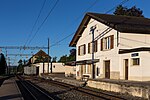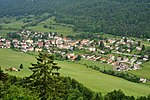La Chaux-d'Abel railway station
Chemins de fer du Jura stationsPages with no open date in Infobox stationRailway stations in the canton of Bern

La Chaux-d'Abel railway station (French: Gare de La Chaux-d'Abel) is a railway station in the municipality of La Ferrière, in the Swiss canton of Bern. It is an intermediate stop and a request stop on the 1,000 mm (3 ft 3+3⁄8 in) metre gauge La Chaux-de-Fonds–Glovelier line of the Chemins de fer du Jura.
Excerpt from the Wikipedia article La Chaux-d'Abel railway station (License: CC BY-SA 3.0, Authors, Images).La Chaux-d'Abel railway station
248.1,
Geographical coordinates (GPS) Address Nearby Places Show on map
Geographical coordinates (GPS)
| Latitude | Longitude |
|---|---|
| N 47.153055555556 ° | E 6.8988888888889 ° |
Address
248.1
2333
Bern, Switzerland
Open on Google Maps








